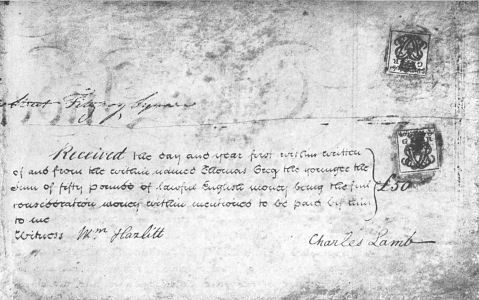Charles Lamb once lived at Button Snap and the following is an extract from the long account
of the cottage (including a picture) in the book
Charles Lamb and His Hertfordshire
|
Charles Lamb purchased Button Snap in 1812 and sold it for £50 as this receipt shows. |
 |
|
|
And, with something like a sigh, we must leave Puckeridge, skirt the noble park of Coles, once the stately home of Squire Greg, to be pronounced Grig as Lamb spelt it, and make for Button Snap. It is not difficult, as you lean over the cottage gate, to conjure back the past: Lamb's immense pride of sudden freeholdership: 'When I journeyed down to take possession, and planted foot on my own ground, the stately habits of the donor descended upon me, and I strode (shall I confess the vanity?) with larger paces over my allotment of three quarters of an acre, with its commodious mansion in the midst, with the feeling of an English freeholder that all betwixt sky and centre was my own' ; the letter to the tenant Sargus forgiving him the Michaelmas 1814 rent; and the disposal of the messuage or tenement and its appurtenances for a mere £50 in the following year. You may even join in the game of snap that has been played this last hundred years over the naming of the cottage. So whimsical, so Lambesque is it, that commentators leapt to the conclusion that the new owner, as soon as the indentures of Lease and Release dated 20th and 21st August 1812 came into his hands, must have given the property a new name. Some, like myself, have pored over the earlier title-deeds, but the parchments yield no clue. By diligent inquiry E. V. Lucas discovered an Eliza Button - said to be one of Lamb's innumerable cousins - to whose album he had contributed an acrostic, now in the library of the University of Texas, on the name of Button. We know furthermore that Hertfordshire is bursting with Buttons. But, most likely, the name is a corruption from Bury-tons Knapp, so styled from the rising ground or knob or knap on which it stands, close to the traces of an ancient moat surrounding the old Bury of the de Tany family at Westmill Green. This derivation had the support of the late Archibald Jackson - a dependable local historian, but there was weight, he thought, in the derivation from Burton, a surname he had found in Westmill deeds in 1623, 1663, and 1726, and which, later, had given its name to a field called Burton's Pightle. |
||
[Picture by Jeff Tomlinson, Geograph]
Images of England has picture and listed building details
| April 2013 | page created |